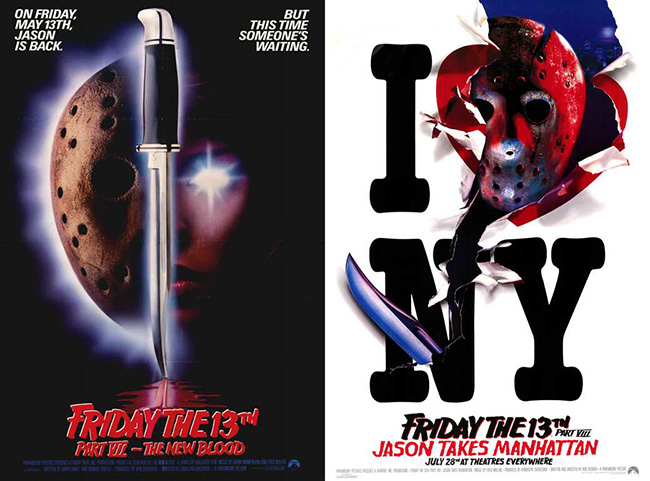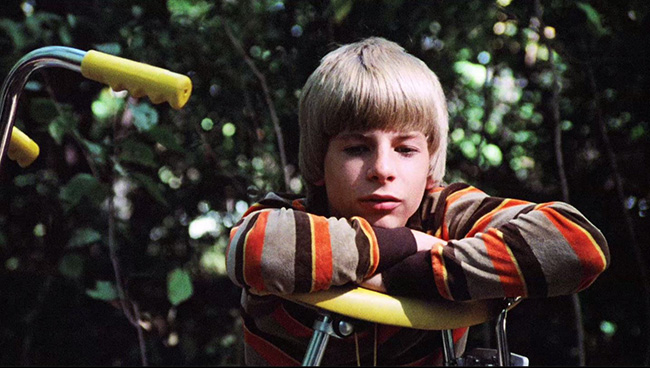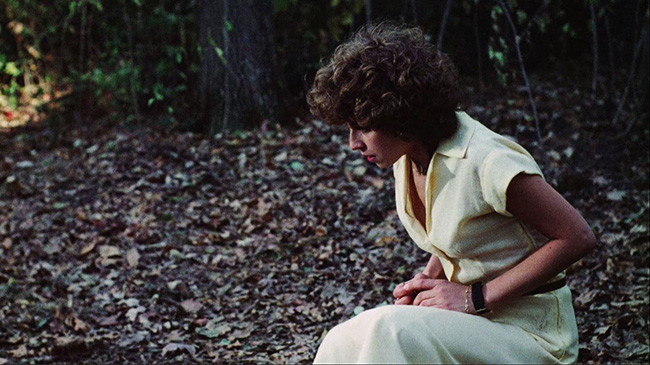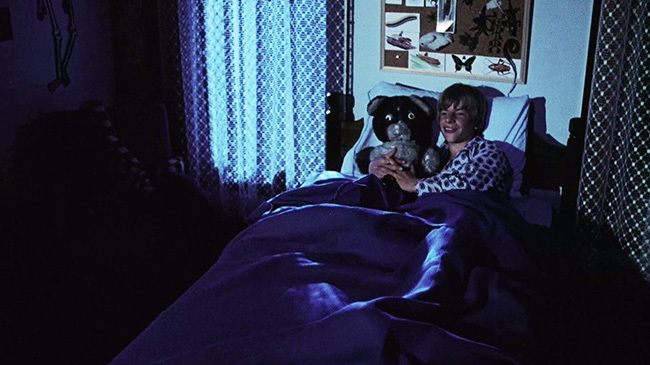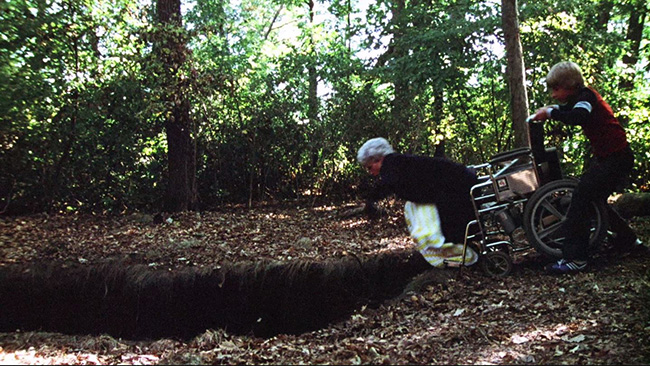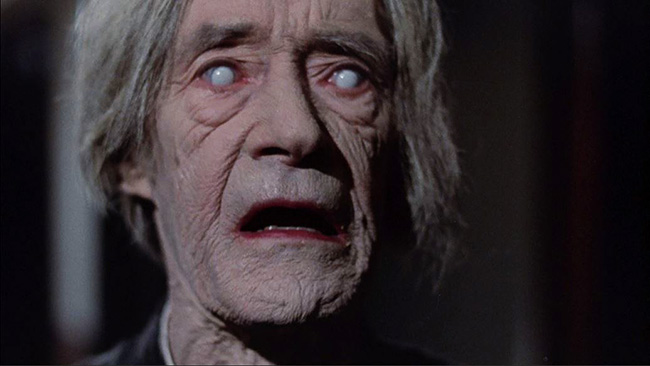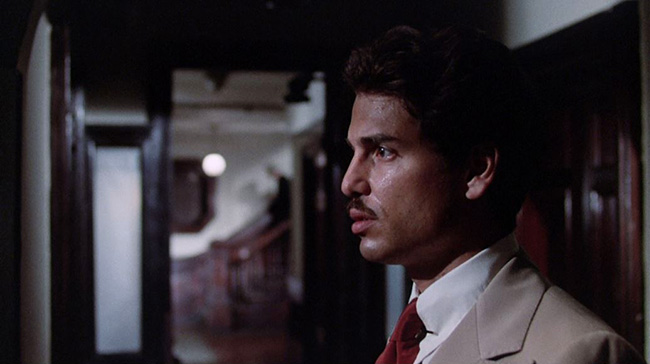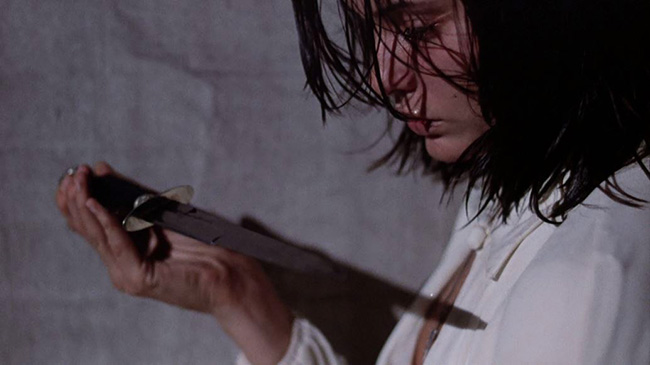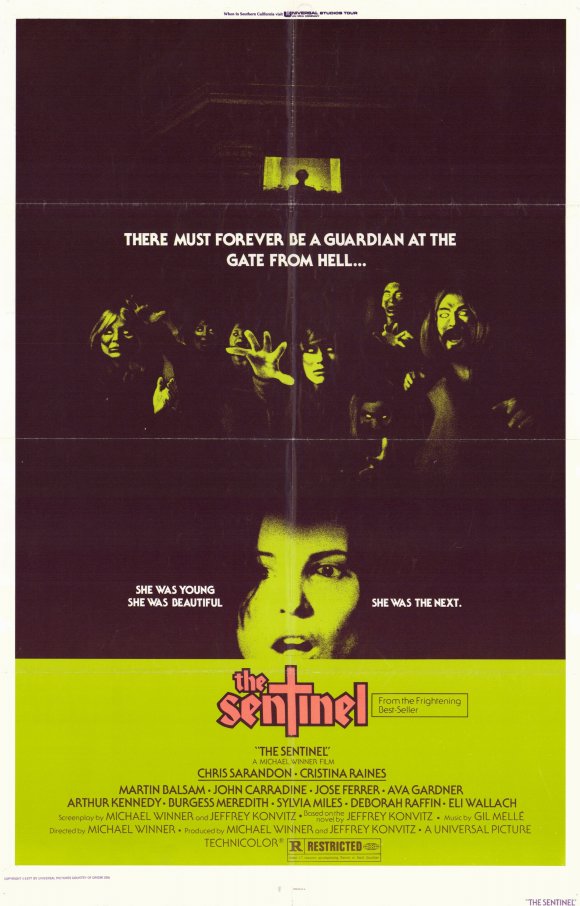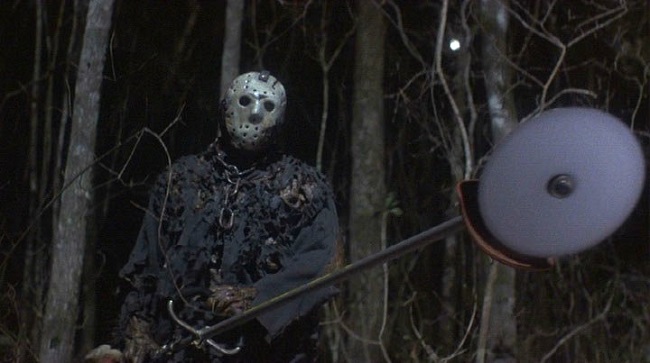
In revisiting the “Friday the 13th” series (this post will likely be the last of my reviews, wrapping up the 1980’s), I have been diligent to scribble down the name of every character as they’ve been introduced on-screen – each and every naïve hitchhiker, cross-eyed caretaker, horny camp counselor, and defensive sheriff – in hopes of writing an accurate review. But I have my limit, and that limit turns out to be Friday the 13th Part VII: The New Blood (1988). This episode, directed by noted makeup effects artist John Carl Buechler (director of the first Troll) and written by Daryl Haney and Manuel Fidello, introduces one teenager after another so quickly and indifferently that one wonders if they’re being spawned like tadpoles in Crystal Lake. Hardly a scene goes by without another fresh-faced future victim being introduced, until this little cabin in the woods is swollen to bursting. At one point late in the film, a character (don’t ask me who) is being stalked by Jason, and slowly she reaches out toward a dreaded door, the audience expectation being that the killer is standing behind it. I predicted – to my wife and witness – that it would instead be yet another new character, and I was right, because the jump-scare cat that springs out at the woman was a pet that neither one of us recognized at all. Maybe there was a cat in one of the previous scenes; anything’s possible. Or maybe it was in hiding to avoid getting stepped on by the multitude. Suffice it to say, I will use only the names of the main characters going forward, and you can just presume the cast of hundreds sucking up all the oxygen around them.
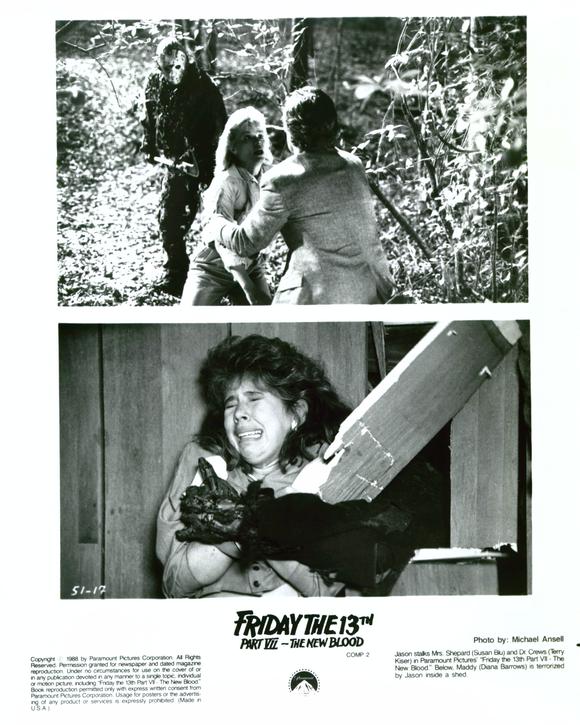
Production stills from “Friday the 13th Part VII: The New Blood.”
Out of boredom – and, believe me, this is a very boring film – I began to wonder if there weren’t some secret storyline lurking just below the surface. What if all these teenagers have been manufactured, assembled on a factory line by scientists on just the other side of the lake? It might explain why they all begin having sex in different locations at the exact same moment. A kind of pre-programmed cycle? Note the behavior of one character – and I did catch her name, it’s Melissa (Susan Jennifer Sullivan of Charles in Charge). There’s something mechanical in the way she comes on to one of the other campers, and, when he rebuffs her, randomly selects another to stoke his jealousy. All this, too, seems programmed. She interrupts foreplay with the boy she’s chosen, and says she’s not interested anymore. He says, “Oh, rejection,” as though he recognizes the command written into his coding. Or the girl who, walking for a few minutes into the woods, realizes that she’s lost her earring. She reaches into a random spot in the soil and finds it at once. Surely that’s a million to one chance, but it’s like she knows where it will be. Of course Jason kills her. It’s for his benefit that this performance took place. These are not real teenagers, they are acting according to their software. The film contains a remarkable number of scenes in which teenagers wander into the woods for no reason – I mean, I know the genre, but no reason. I would have welcomed a twist that delved deeper into just what has been happening at Crystal Lake over all these years; are these teens test subjects for this “Jason,” who is really an innovative piece of military hardware? Leave it to a future Friday the 13th to explore.
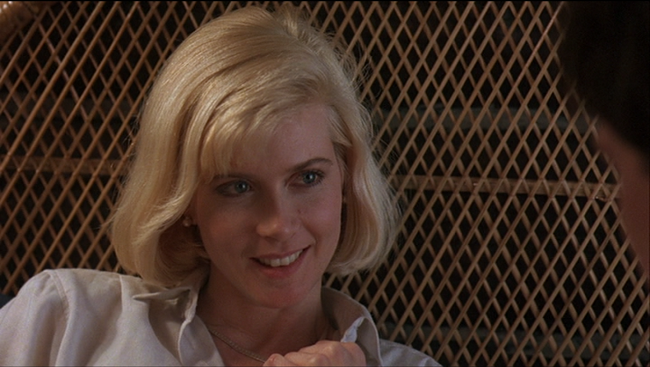
Melissa (Susan Jennifer Sullivan): don’t blame her, blame the microchip.
The New Blood manages the remarkable feat of beating out Friday the 13th: A New Beginning (1985) as the worst Jason film of the 80’s. This is because, as terrible as the writing and acting was in A New Beginning, at least it was entertaining. The New Blood contains not a single moment of suspense or horror. Admittedly, there isn’t a lot of suspense in any of these films (I singled out Part VI for mustering a little). We know what’s going to happen each time around. If handled well, the predictability can be part of the fun. But Part VII is a dried-out husk of a franchise film, humorless, unimaginative, not even going through the motions well. Worse, it is not adequately assembled on a technical level: some brief shots are out of focus, and the editing is haphazard and vaguely nauseating in the lack of natural rhythm. The makeup is good: Jason, whose skeleton is now visible through deteriorating flesh, looks fantastic, particularly when he’s unmasked in the final scenes (he almost has a simian look this time around, which is just fine because his makeup has never been consistent throughout the series). Apart from that, the only element which really sets Part VII apart is that this is the film which fans call “Jason vs. Carrie.” The Final Girl, Tina (Lar Park-Lincoln, House II: The Second Story), has telekinetic powers as well as a psychic link with Jason. We first see her powers demonstrated in a prologue in which a younger Tina witnesses her parents fighting, and, distraught, psychically dismantles a dock on Crystal Lake and drowns her father. Now a young adult, she subjects herself to experiments from Dr. Crews (Terry Kiser, “Bernie” from Weekend at Bernie’s), who believes her telekinesis is linked to her emotional distress. Crews is in a relationship with Tina’s mother, Amanda (Susan Blu), and they’re staying on the same grounds where an armada of teenagers have massed for a birthday party. Unfortunately, Tina accidentally unshackles Jason (Kane Hodder) from below Crystal Lake, played here by a pond. As Jason tirelessly works to winnow down the cast, good man that he is, Tina clashes with Dr. Crews and suffers visions of Jason’s killing spree.
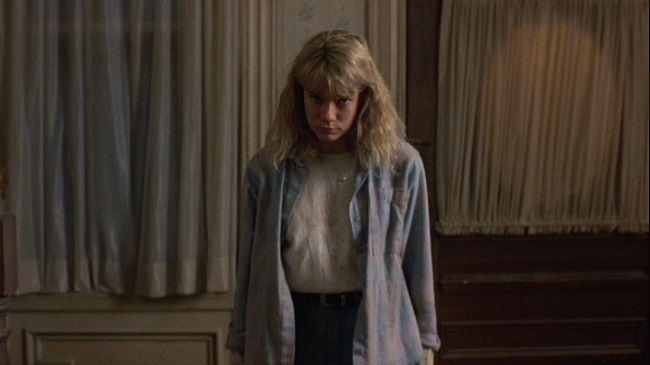
Telekinetic Tina (Lar Park-Lincoln) confronts Jason.
It’s all marking time until Tina and Jason clash, and this amounts to a few good moments, although a lot of it is just Tina throwing couches and TVs at Jason with her mind-powers. But for sheer insanity, witness the climactic moment when Tina actually resurrects her dead father (who has also been sleeping in Crystal Lake – and looks not a day older nor a bit decomposed) to drag Jason back into the depths. That–there–just–what–I don’t–I can’t–huh, fine, OK. Here is my best guess as to what really happened: all the teenagers are robots; Dr. Crews is part of the secret government Jason Voorhees Project, and he is also responsible for Tina’s powers, as part of a secret experiment. Having her interact with Jason is the latest experiment, and the final appearance of her father is just another robot, like an animatronic gator on the jungle ride at Disneyland. Thus the experiment ends, but it has to, because it’s been a disaster: Dr. Crews has been killed by Jason, and Tina has proven she can defeat Jason. So Tina will now be further exploited as a weapon for the military. See? Maybe the movie’s much smarter than it seems.
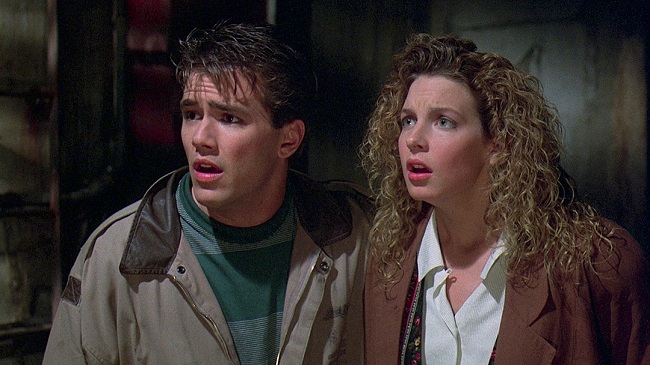
Sean (Scott Reeves) and Rennie (Jensen Daggett) in “Friday the 13th Part VIII: Jason Takes Manhattan.”
The real takeaway from the punishing The New Blood is that the series had finally decided to jump the shark, in TV parlance, as a strategic move. The formula had been repeated so many times that why not insert other random ideas? How about Jason fights a telekinetic teen? How about Jason leaves Crystal Lake for Manhattan? Or how about he goes to Hell? Or he fights Freddy Krueger? Or he’s shot into outer space, just a few years after Hellraiser‘s Pinhead and the lowly Leprechaun trod that territory already? Thing is, the next film, and the last of the Decade of the Slasher, doesn’t quite live up to its perfect exploitation title, Friday the 13th Part VIII: Jason Takes Manhattan (1989). Most of the film, written and directed by TV writer Rob Hedden (MacGyver), takes place not in the Big Apple but on a boat travelling from the Crystal Lake region to New York City. Jason, apparently having decided that he finally deserves a vacation (can you blame him?), hitches a ride. But not before a very silly resurrection scene similar to the one in Part VI, as a yacht’s anchor snags a submerged power cable, sending bolts of electricity through Jason’s sunken corpse. (His death-and-rise pattern has long since grown to emulate the Hammer Dracula series, or even the Universal Frankenstein films.) Jason – played again by Kane Hodder – immediately murders the young couple having sex on the boat, just so he can stretch the muscles a bit. Then he joins up with the NYC-bound ship Lazarus (get it?!), which is hosting a high school graduation party. Slaughter ensues, but nothing tops the early scene in which a Joan Jett wannabe practices for a music video in the bowels of the ship while Jason creeps up on her. Her cameraman is nowhere to be found, nor any audience at all, but this doesn’t stop her from cranking up the ghetto blaster and lip syncing her rock song while faking at playing the guitar. It’s a pointless gesture completely free of motivation, and so I can only assume she is a robot too. I mean, why else?
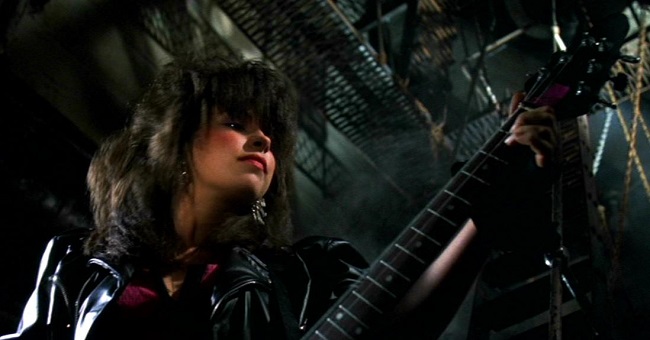
Rocker J.J. (Saffron Henderson) dreams of electric sheep.
The Final Girl here not only has an adorable name, Rennie, but is played by an adorable actress, Jensen Daggett (Home Improvement). As with Tina in the previous film, Rennie is haunted by visions of Jason – but this time it’s Jason as a young boy drowning in the lake. In one of the more striking shots in the film, Rennie sees the drowning boy materialize outside the porthole of her cabin, pounding on the window, before the image vanishes into shadows. Rennie has a fear of water – for reasons explained late in the film, and reasons that tie directly into her connection with Jason – so it doesn’t help when mean girl Tamara (Sharlene Martin, Possession) pushes her over the edge of the boat. While Rennie’s still drying out, Tamara seduces and blackmails the teacher, Rennie’s uncle Charles (Peter Mark Richman, The Naked Gun 2 ½). Jason proceeds through his kill list, at one point memorably putting a hot sauna rock to use. It’s notable that even though we’re no longer in Camp Crystal Lake, there’s still a crazy caretaker type working on the boat who warns everyone that Jason’s back. In fact, it becomes clear that the reason so much of Jason Takes Manhattan takes place on a boat is that placing him in the city removes too much of the franchise mechanics. Jason is an urban legend type, best suited to the woods, or dark secluded places. Once he’s actually put into the bright lights, big city, he seems pretty absurd. He stalks straight through Times Square and rides the subway. When he busts a gang’s boom box (he doesn’t like 1989-era rap, apparently), he scares them off by merely doffing his mask and showing them his real face. (That face, when you see it, is a major disappointment. The makeup effects are nowhere near as effective as in the prior film, even though this film is more slickly made.)
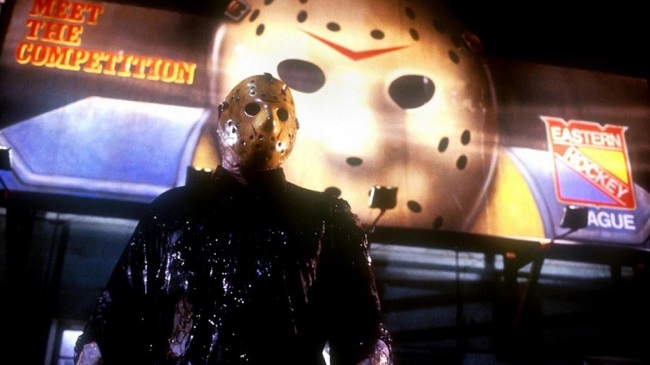
Jason (Kane Hodder) takes Manhattan.
So the payoff to Jason Takes Manhattan isn’t quite what we were hoping for, despite the expected jokes: when Rennie pleads to a fry cook, “You don’t understand, there’s a maniac trying to kill me!” she responds, nonplussed, “Welcome to New York.” Perhaps if the entire film took place in New York City, the locale would be used more creatively. As it stands, much of this is shot in Vancouver, and the NYC on display is one that seems more closely related to Tromaville. Jason kills the loathsome Uncle Charles by dumping him in a barrel of toxic waste – green, of course – and every night, we learn, the sewers are flooded with even more toxic waste. With Jason becoming the Toxic Avenger, he even gets to save Rennie from some Latino gang-bangers who shoot Rennie up with heroin and then attempt to rape her, in a jarring off-note for the series. (Frankly, sexual assault just doesn’t belong in the “Friday the 13th” universe. As for broad, insulting ethnic stereotypes…yeah, they’ve gone there.) The climax is every bit as silly as the one in The New Blood, but at least this time it includes the novelty of catharsis delivered by the Statue of Liberty dramatically struck by lightning, and Jason returned to his childhood form, as if purified. Jason Takes Manhattan is a messy, nutty movie, and it would prove to be the last Paramount Pictures Friday the 13th for a while. But there would be no resting for Jason. New Line Cinema continued the franchise with Jason Goes to Hell: The Final Friday (1993), Jason X (2001), and – in the spirit of the Universal monster mashes of the 40’s – Freddy vs. Jason (2003), before Paramount produced the failed reboot Friday the 13th (2009).
